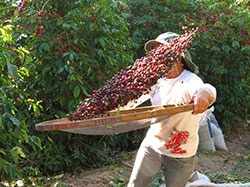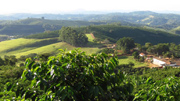- Home
- How to Store Coffee for Optimal Freshness
How to Store Coffee for Optimal Freshness
Much though we might want to, most of us don't consume an entire bag of coffee in one sitting. (Not when others are watching, anyway.) Which leaves us with a problem: how should you store your coffee so it stays fresh as long as possible?
Coffee Storage Lesson One: Oxygen Is The Enemy
When preserving perishables like meat and milk , your true foe is spoilage--in other words, bacteria. To battle bacteria, you use cold. That slows the growth of bacteria to retard spoilage. But bacteria is not a problem for coffee. Your fridge or freezer won't help at all, because you're fighting the wrong enemy.
What causes your coffee to fade away is oxygen. The volatile aromas and flavors that make your coffee amazing are incredibly vulnerable to oxidization, and once oxidized, they're dead.
The only way to protect your coffee from oxidizing is to keep it away from air. Your freezer is not nearly cold enough to slow down the oxidization process enough to matter.
Coffee Storage Lesson Two: Your Fridge/Freezer Is Ruining Your Coffee
Fridges and freezers both contain things that smell. Onions, cheese, eggs, leftover garlicky pizza, you get the picture. Coffee will soak up those smells faster than baking soda. Who wants a cup of coffee that smells like their freezer? Not us. (Though, if you're into that kind of thing, go for it. We won't judge.)
Worse, your freezer especially can ruin your coffee by causing frost to form on it. Getting your coffee wet is one of the quickest ways to destroy it. Plus, anyone who has tried to eat ice cream that's been left in there too long and has frost all over it knows those crystals don't taste good.
Coffee Storage Lesson Three: Your "Airtight" Jar Is Also Ruining Your Coffee
One word: headspace.
The problem with jars is, there's always air at the top of the jar. The less full the jar is, the more air is in there. That air is called "headspace". Every time you open the jar, you let in a fresh batch of oxygen-filled air. It's better than letting your coffee sit in an open bowl on the countertop, but not by much.
So, what should you do? Coffee Storage Final Lesson: Keep Your Coffee In A Sealed, Room-Temperature Bag
It's that simple.
If you keep your coffee in a bag (ideally, the one it came in, if you bought your coffee already roasted), you can easily minimize its exposure to oxygen: squeeze the air out of the bag, fold its top down, and secure it with a clip, rubber band, or piece of tape. This way, only the top layer of coffee is exposed to the air, and that exposure is kept to a bare minimum. As a nice side benefit, this storage method is easy, cheap, and convenient.
If you want to get fancy, use a vacuum sealer.
Personally, we don't bother with these contraptions except when sealing roasted coffee in preparation for shipping to customers, when long-term storage is important. Vacuum sealing is overkill for your average kitchen. However, if you have access to a vacuum food preserver and want to use it, go for it! You will find that vacuum sealing provides the absolute maximum shelf life for your coffee.
If You Simply Must Freeze Your Coffee, Here's How To Do It Right
If you are storing your coffee for three months or more, and don't intend to keep opening and closing it during that time, then the freezer might make sense. For example, if you're saving some coffee for a special occasion, or a gift. The reason you might use the freezer under these circumstances is because the oils in coffee can eventually start to turn bitter. Your freezer might help to slow this process down. However, all the above-mentioned drawbacks still apply. Moisture and scents will attack your coffee while it sits in the freezer.
To store your coffee in the freezer without ruining it, you must use a zip-top plastic bag that is specifically labeled as a freezer bag. Only freezer bags are made of the right type and thickness of plastic to protect your coffee. If your coffee is already in a bag, keep it in that bag--don't pour it out, just put the whole thing, coffee bag and all, into the zip-lock bag. Then put the whole shebang into a second zip-top bag, in case the first one has a leak.
Latest Blog Post

Get to know our Brazil Microlots!
These volcanic soil coffees are delicious and diverse... Read more...
Resources
Featured Region

The Araku Valley of India
India's coffee tradition goes back 400 years or more, when a variety called Kent was first established in the Southern Hills. Arabicas predominated until the blight of 1870, when growers needed to hybridize to resistant varieties. The resultant strains had genes from Liberica and other unique, resistant species. Learn more and browse India's Araku Valley coffees here.
 Loading... Please wait...
Loading... Please wait...


